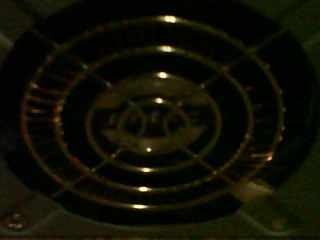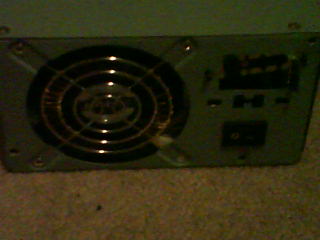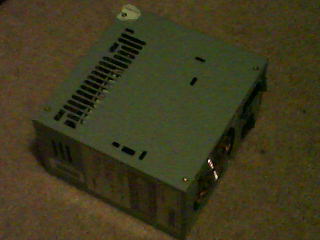
This is the heating coil of wire wound around the grille that was already on the power supply. The wire has a coating of insulation on it so it does not conduct through the grille.
The idea for this project came from experimentation with a large 6 volt battery, which I found puts out enough current to melt thin metal wire. It follows that a useful project could then include the resistance heating capability of this battery combined with a fan, and that is what I wanted to make. The way most resistance heaters work is with a coil or double coil of wire wound around in a circle behind the fan. These coils heat up when a current is supplied and because of the large ratio of surface area to volume in a coil configuration most of the heat is transferred to the air pulled through by the fan. Thus all I needed was really thin wire (a thick one would not heat up enough), something to coil it around, a fan, and a power supply.
The construction of this project is rather simple. First, unwind the inductor to get a long thin wire. Second, find a length of wire such that it barely gets red hot when connected to the 6V battery (note the wire has thin insulation on it and this should be stripped off using sandpaper or a knife in order to connect it to a battery). Third, wind this wire around the fan grille so it is exposed to air flow from the fan. Fourth, attach this to the fan. Fifth, attach everything to the switch and battery in whatever configuration you like. I made it so one mode switched on the fan, another two put the heating coil and fan in parallel with one or two resistors in series with heating coil, and a fourth one with the fan and coil in parallel with no resistors.

This is the heating coil of wire wound around the grille that was already on the power supply. The wire has a coating of insulation on it so it does not conduct through the grille.


This shows the switch set-up described above, internally and externally. The mode switch on top right has four positions, which are fan only, fan+coil in series with 94Ohm resistance on coil, fan+coil with 47Ohm resistance, fan+coil in parallel (full power). The on/off switch turns the entire circuit on or off.

The internal structure of completed heater with battery in place.

The completed heater from outside.
I guess I was overly optimistic about the power output of the 6V battery, or this project was not entirely efficient at creating heat. The air coming out was warm, but not very much so. On full power (with fan and coil in parallel and no resistors) I could feel the heat when the battery was full but after a few minutes of use there was barely any warm air coming out. Overall, it is not very useful - this will not help out much if you go winter camping. That was actually one reason I wanted to try out this project. It could work with a car battery, but at that point you might as well just use the car's heater. If you are looking for a quick source of heat though (such as for a hand warmer), connecting two 9V batteries to each other will do the task.